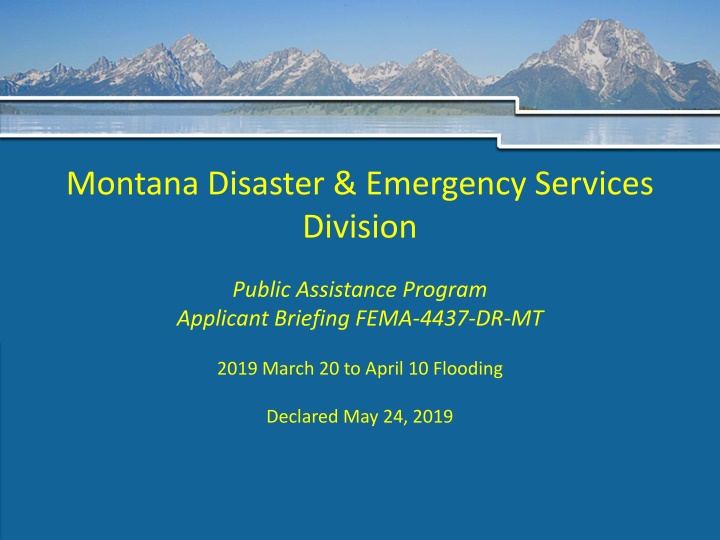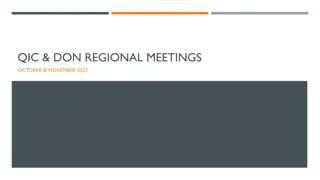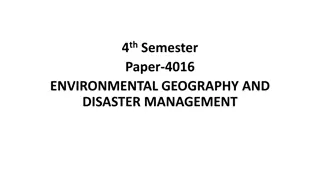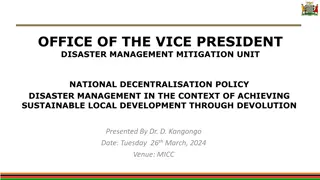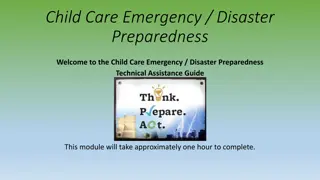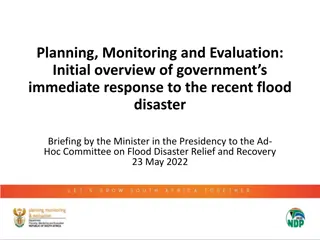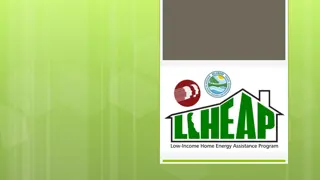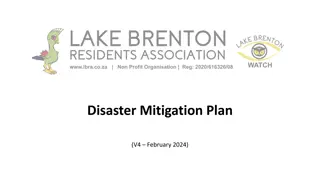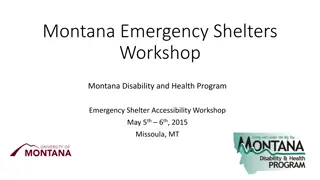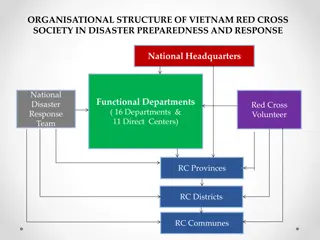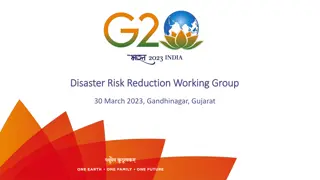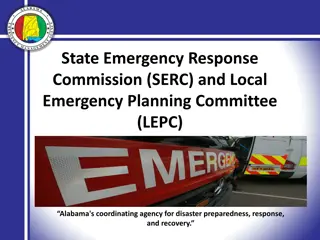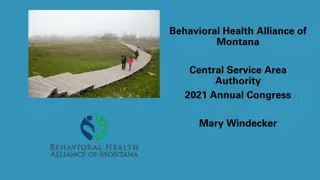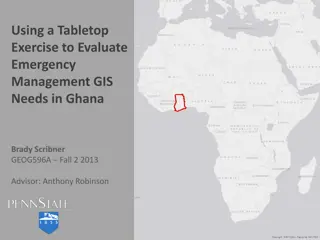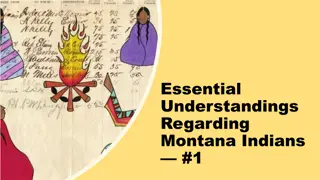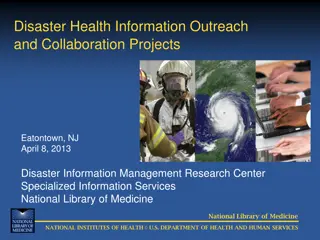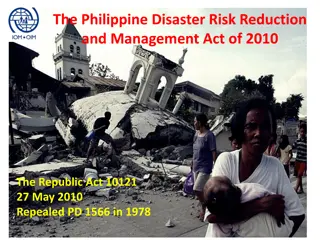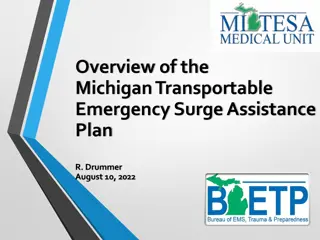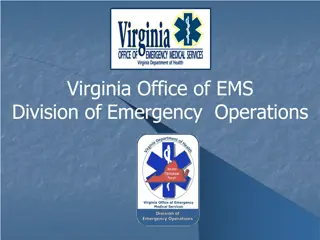Montana Disaster & Emergency Services Division Public Assistance Program
This briefing covers the Public Assistance Program in Montana for applicants affected by the March-April 2019 flooding, including eligibility criteria, funding, and special concerns. It details governing documents, acronyms used in the process, and eligibility requirements for applicants.
Download Presentation

Please find below an Image/Link to download the presentation.
The content on the website is provided AS IS for your information and personal use only. It may not be sold, licensed, or shared on other websites without obtaining consent from the author.If you encounter any issues during the download, it is possible that the publisher has removed the file from their server.
You are allowed to download the files provided on this website for personal or commercial use, subject to the condition that they are used lawfully. All files are the property of their respective owners.
The content on the website is provided AS IS for your information and personal use only. It may not be sold, licensed, or shared on other websites without obtaining consent from the author.
E N D
Presentation Transcript
Montana Disaster & Emergency Services Division Public Assistance Program Applicant Briefing FEMA-4437-DR-MT 2019 March 20 to April 10 Flooding Declared May 24, 2019
Applicant Briefing Purpose Explain How Public Assistance Works Identify Eligible Applicant Identify Eligible Work Discuss Areas of Special Concern Discuss Funding Answer Your Questions
Governing Documents Statue - Robert T. Stafford Act as Amended Regulations - Code of Federal Regulations: 44 CFR Part 206 and 2 CFR Part 200 Public Assistance Program & Policy Guide (PAPPG)
The Public Assistance Process (New Model) Acronyms Program Delivery Manager (PDMG) Site Inspector (SI) Consolidated Resource Center (CRC) Environmental Historic Preservation (EHP) Damage, Description and Dimension (DDD) Statement of Work (SOW) Joint Field Office (JFO)
The Public Assistance Process (New Model) Disaster Event Joint PDA Applicant Declaration Briefing 5
The Public Assistance Process (New Model) PA Program Eligibility Cost Work Facility Applicant 6
The Public Assistance Process (New Model) Applicant Eligibility Counties, Incorporated Municipalities Other Legally Constituted Units of Local Government State Government Agencies and Departments Indian/Tribes or Authorized Tribal Organizations Certain Essential Private Non-Profits
The Public Assistance Process (New Model) Eligibility Basic Requirements Damage is Caused by This Disaster Damage Must be in the Declared Area Must be the Applicant s Legal Responsibility Must Meet Complete Eligibility Requirements
The Public Assistance Process (New Model) Disaster Event Joint PDA Applicant Declaration Briefing Submit Request for Public Assistance 9
Request for Public Assistance (RPA) Initial Step in Request Process Applicant Completes and Submits FEMA Form 90-49 (RPA) If You Have Completed, Complete and Submit Today All Requests Must be in by June 24, 2019 Is Not a Guarantee of Assistance Funding
Applicants Agent Form Identifies Single Point of Contact Oversees Applicant s Program Participation Identifies Responsible Person for Record Keeping and Documentation Complete and Return Form to State Must be Actively Involved in the Project
The Public Assistance Process (New Model) Disaster Event Joint PDA Applicant Declaration Briefing Recovery Scoping Submit Request Exploratory Call for Public Assistance Meeting Program Delivery 13
Exploratory Call Introduces your Program Delivery Manager (PDMG) Damage Inventory Form Discussion Documentation Needed for Support Schedule Recovery Meeting Allow Time to Draft Damage Inventory Recovery Scoping Meeting Objectives Discussed
Damage Inventory Critical Outlines ALL Damage Can be Updated (Deadline: 60 Days Following Recovery Scoping Meeting)
Recovery Scoping Meeting Follows Applicant Briefing & Exploratory Call PDMG Schedules with the Applicant Establishes Partnership Between FEMA, State, and the Applicant Designed to Focus on the Needs of each Applicant In Depth Discussion of Damage Inventory
Facility Eligibility Buildings Works (Drainage, Flood Protection) Systems (Water, Utilities) Roads Bridges Equipment Vehicles
The Public Assistance Process (New Model) Disaster Event Joint PDA Applicant Declaration Briefing Phase II Recovery Scoping Submit Request Exploratory Call for Public Assistance Meeting Program Delivery 18
Phase II Three Tracks Completed Work Work To Be Completed Standard, Non-Technical Work To Be Completed-Specialized, Technical
Categories of Work (Emergency) Category A: Debris Removal Category B: Emergency Protective Measures
Categories of Work (Permanent) Category C: Roads and Bridges Category D: Water Control Facilities Category E: Buildings and Equipment Category F: Utilities Category G: Parks, Recreation Facilities and Other Items
Phase II Completed Work Track Document Work Completed Routed to CRC CRC Validates & Develops DDD, SOW/Costs CRC Reviews: QA, Insurance Joint Field Office Reviews: Mitigation, EHP PDMG Reviews DDD, SOW/Costs Recipient Reviews Applicant Reviews & Signs Project
Phase II Standard, Non-Technical & Specialized, Technical Tracks Site Inspection Work Order for Work to be Completed Site Inspection (FEMA site visit) PDMG & Applicant Review & Sign Off Site Inspection Report Damage, Description and Dimension
The Public Assistance Process (New Model) Phase III Phase II Disaster Event Joint PDA Applicant Declaration Briefing Scoping & Costing Recovery Scoping Submit Request Exploratory Call for Public Assistance Meeting Program Delivery 24
Phase III Scoping and Costing Decision/Option: FEMA or Applicant Develops Statement of Work/Costs?
Phase III Scoping and Costing If FEMA, CRC Develops SOW/Costs Program Compliance (Insurance, Mitigation, & EHP Reviews) - COST determined by Actual, RS Means or CEF PDMG Reviews & OKs Recipient (State) Reviews & OKs Applicant Reviews & OKs
Phase III Scoping and Costing Applicant Develops Statement of Work/Costs FEMA CRC Validates SOW/Costs QA Review
Phase III Scoping and Costing (cont.) Program Compliance (Insurance, Mitigation, & EHP Reviews) PDMG Reviews & OKs Recipient (State) Reviews & OKs Applicant Reviews & OKs
Work Eligibility Direct Result of the Disaster Incident Period: March 20 April 10, 2019 Damage Located in Declared County Legal Responsibility of Eligible Applicant In Active Use at Time of Disaster
Work Eligibility (Cont) Must Follow Local/State/Federal Procument Standards 2 CFR Contracts Competitive Bids Contract Must Follow Scope of Work Outlined in Project Worksheets Reasonableness of Cost Changes MUST be Approved in Advance
Work Eligibility (Cont) Codes and Standards Must Apply to the Repair Work Being Performed Must be Reasonable, Formally Adopted in Writing and Implemented Prior to Declaration Date (May 24, 2019) Must Apply Uniformly to All Facilities of the Type Being Repaired Must Have Been Enforces When in Effect
Cost Eligibility Reasonable, Necessary and Disaster Related Mutual Aid Agreements (Payments cannot be contingent on receiving FEMA funding)
Cost Eligibility (Cont) Force Account Labor Emergency Work Overtime and Benefits of Regular Employees in Most Cases Regular, Overtime and Benefits of Temporary Hires Permanent Work Regular, Overtime and Benefits of Regular Employees and Temporary Hires
Cost Eligibility (Cont) Equipment Force Account FEMA Rate Schedule (2017 Rates) https://www.fema.gov/schedule-equipment-rates Includes: Cost of Ownership, Operation, Depreciation, Maintenance, Repairs, Fuel, Lubricants, Tires and OSHA Equipment Standby Time is NOT Eligible Rented (Copy of Agreement Needed) Contracted
Cost Eligibility (Cont) Material Used Only for Eligible Work Purchased for Disaster Used from Applicant s Stock Purchase Must be Documented Commercial Borrow Site Department of Environmental Quality Approved Borrow Locations State Historic Preservation Approved Borrow Locations
Cost Eligibility (Cont) Contracts Competitively Bid Reasonable Cost Compliant with Federal, State and Local Procurement Standards - 2 CFR Contractors and Sub-Contractors Eligible and NOT Debarred https://sam.gov/portal/sam
Types of Project Worksheets Minimum Project Worksheet > $ 3,200 Small Projects < $128,900 Large Projects > $ 128,900
Project Worksheets Grant Document in Which Scope of Work and Eligible Costs are Identified FEMA S Funding Document Includes Review of Special Considerations If Costs Increase from Estimates on Worksheet .
Project Worksheet Formulation Combining Associated Work Into Projects Developing Scope of Work and Costs for the Project Identifying Any Special Considerations
Admin/Management Costs Administrative/Management Costs: Properly Documented DAC cost up to 5% of total awards less insurance. Separate worksheet and will be treated as a large project with a closeout process documenting actual costs.
The Public Assistance Process (New Model) Phase III Phase II Disaster Event Joint PDA Applicant Phase IV Declaration Briefing Obligation Scoping & Costing Recovery Scoping Submit Request Exploratory Call for Public Assistance Meeting Program Delivery 41
Phase IV Obligation Recipient Approval in EMMIE Final Approval in EMMIE Obligation Exit Briefing
Time Constraints Emergency Work 6 Months for Completion After Declaration State May Approve 6-Month Extension (for a total of 12 months) Need FEMA Approval for Changes in Scope of Work or Costs Improved Projects
Time Constraints Permanent Work 18 Months for Completion from Declaration Date State May Approve 30-Month Extension Need FEMA Approval for Changes in Scope of Work or Costs Improved Projects
Time Extensions If Needed, Notify the State Immediately - Always Prior to Performance Period End Applicants Request Must Include: Project Number Project Completion Date Justification Justifications Should be Based on Extenuating Circumstances or Unusual Requirements Beyond the Applicant s Control
Special Considerations Insurance Floodplain Hazard Mitigation (406 Mitigation) Environmental Historical Preservation Additional Federal/State Compliance Requirements All Will be Outlined in the Grant Award Agreement Project Worksheet
Permits (Prior to Start of Work) Check with Community Flood Plain Management for Requirements for Projects Ensure Montana DNRC Consulted for Stream Related Projects Ensure Montana Regulatory Office of USACE Consulted for Stream Related Projects Ensure Montana FW&P Office Consulted
Issues Fill Dirt, Gravel, Rip Rap MUST Come From a DEQ/SHPO Pit OR a Commercial Source Insurance Commitment Track ALL Costs for Audit Purposes Debarment of Contractors Projects Should Not Generate Additional Income (Interest, Salvage, etc.) Account for PW Funds Separately Work on Major collectors not eligible
Hazard Mitigation Section 406 OF Stafford Act (Mitigation) Cost Effective Measure that Would Reduce or Eliminate the Threat of Future Similar Damage Considered Part of Total Eligible Cost of Repair of Damaged Facility Only for Permanent Work Projects Must be Approved Prior to Work Start
Funding Federal Share 75% State/Local/PNPs Cost Share 25% If Costs Look Like They May Exceed Worksheet Estimates Contact MT DES
Cost Share FEMA approves an annual Public Assistance Administrative Plan developed by the State of Montana. Assures that Montana is prepared to coordinate and administer disaster related FEMA Grants Establishes general financial expectations for state, local, and federal agencies 75% Federal Share 25% Local Share (non-federal share) A disaster specific Administrative Plan is also required for each declared federal disaster.
